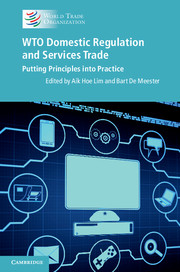Book contents
- Frontmatter
- Contents
- List of contributors
- Foreword
- Disclaimer
- Acknowledgements
- List of abbreviations
- 1 An introduction to domestic regulation and GATS
- Part I Impediments to services trade, regulatory theory and principles
- Part II Legal perspectives on WTO principles and domestic regulations
- Part III Case studies
- Part IV Concluding remarks
- Index
- References
1 - An introduction to domestic regulation and GATS
Published online by Cambridge University Press: 05 April 2014
- Frontmatter
- Contents
- List of contributors
- Foreword
- Disclaimer
- Acknowledgements
- List of abbreviations
- 1 An introduction to domestic regulation and GATS
- Part I Impediments to services trade, regulatory theory and principles
- Part II Legal perspectives on WTO principles and domestic regulations
- Part III Case studies
- Part IV Concluding remarks
- Index
- References
Summary
Introduction
International trade in services is governed principally by regulatory measures. Unlike trade in goods, border measures in the form of tariffs and quotas are not the main barriers to trade. This peculiarity of services trade is due to the manner by which services are produced and consumed. Due to the intangible and non-storable nature of services, suppliers and consumers often have to be in physical proximity to each other for the transaction to be completed. For this reason, economists have traditionally considered services to be non-tradable across borders and have paid little attention to it in trade theory.
Yet, in today’s global economy, trade in services is very much a tangible phenomenon – representing over one-fifth of international trade. With technological improvements, there are now greater possibilities for services to be supplied over a distance. Moreover, services trade as defined by the first multilateral agreement on this subject, the General Agreement on Trade in Services (GATS), encompasses not only cross-border trade (Mode 1), but also the consumption of services abroad (Mode 2), commercial establishment of service suppliers in another territory (Mode 3) and the presence of foreign natural persons for the supply of services (Mode 4). Given that the GATS modal coverage goes beyond traditional product-based trade flows, a far wider range of measures fall under the scope of the agreement.
- Type
- Chapter
- Information
- WTO Domestic Regulation and Services TradePutting Principles into Practice, pp. 1 - 22Publisher: Cambridge University PressPrint publication year: 2014



